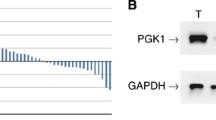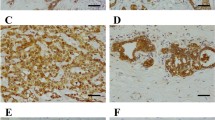Abstract
Purpose
Breast cancer is the most common type of cancer affecting women worldwide. Phosphoglycerate dehydrogenase (PHGDH) is an oxidoreductase in the serine biosynthesis pathway. Although it has been reported to affect growth of various tumors, its role in breast cancer is largely unknown. This study aimed to analyze the expression of PHGDH in breast cancer tissue samples and to determine if PHGDH regulates breast cancer cell proliferation.
Methods
Tissue microarrays consisting of 305 cases of breast invasive ductal carcinoma were used for immunohistochemical evaluation of PHGDH expression. The role of PHGDH in breast cancer was investigated in vitro by knocking down its expression and determining the effect on cell proliferation and cell cycling, and in ovo by using a chorioallantoic membrane (CAM) assay.
Results
Immunohistochemical examination showed that PHGDH is mainly localized in the cytoplasm of breast cancer cells and significantly associated with higher cancer grade, larger tumor size, increased PCNA expression, and lymph node positivity. Analysis of the GOBO dataset of 737 patients demonstrated that increased PHGDH expression was associated with poorer overall survival. Knockdown of PHGDH expression in breast cancer cells in vitro resulted in a decrease in cell proliferation, reduction in cells entering the S phase of the cell cycle, and downregulation of various cell cycle regulatory genes. The volume of breast tumor in an in ovo CAM assay was found to be smaller when PHGDH was silenced.
Conclusion
The findings suggest that PHGDH has a regulatory role in breast cancer cell proliferation and may be a potential prognostic marker and therapeutic target in breast cancer.






Similar content being viewed by others
References
Bray F, Ferlay J, Soerjomataram I, Siegel RL, Torre LA, Jemal A (2018) Global cancer statistics 2018: GLOBOCAN estimates of incidence and mortality worldwide for 36 cancers in 185 countries. CA Cancer J Clin 68:394–424
National Registry of Diseases Office (2017) Singapore Cancer Registry Annual Registry Report 2015. Singapore, Health Promotion Board
Mattaini KR, Sullivan MR, Vander Heiden MG (2016) The importance of serine metabolism in cancer. J Cell Biol 214:249–257
Hamanaka RB, Chandel NS (2012) Targeting glucose metabolism for cancer therapy. J Exp Med 209:211–215
Vander Heiden MG, Cantley LC, Thompson CB (2009) Understanding the Warburg effect: the metabolic requirements of cell proliferation. Science 324:1029–1033
Locasale JW, Grassian AR, Melman T, Lyssiotis CA, Mattaini KR, Bass AJ, Heffron G, Metallo CM, Muranen T, Sharfi H, Sasaki AT, Anastasiou D, Mullarky E, Vokes NI, Sasaki M, Beroukhim R, Stephanopoulos G, Ligon AH, Meyerson M, Richardson AL, Chin L, Wagner G, Asara JM, Brugge JS, Cantley LC, Vander Heiden MG (2011) Phosphoglycerate dehydrogenase diverts glycolytic flux and contributes to oncogenesis. Nat Genet 43:869–874
Possemato R, Marks KM, Shaul YD, Pacold ME, Kim D, Birsoy K, Sethumadhavan S, Woo HK, Jang HG, Jha AK, Chen WW, Barrett FG, Stransky N, Tsun ZY, Cowley GS, Barretina J, Kalaany NY, Hsu PP, Ottina K, Chan AM, Yuan B, Garraway LA, Root DE, Mino-Kenudson M, Brachtel EF, Driggers EM, Sabatini DM (2011) Functional genomics reveal that the serine synthesis pathway is essential in breast cancer. Nature 476:346–350
Mullarky E, Mattaini KR, Vander Heiden MG, Cantley LC, Locasale JW (2011) PHGDH amplification and altered glucose metabolism in human melanoma. Pigment Cell Melanoma Res 24:1112–1115
Zogg CK (2014) Phosphoglycerate dehydrogenase: potential therapeutic target and putative metabolic oncogene. J Oncol 2014:524101
Bleicher RJ (2018) Timing and delays in breast cancer evaluation and treatment. Ann Surg Oncol 25:2829–2838
Hueman MT, Wang H, Yang CQ, Sheng L, Henson DE, Schwartz AM, Chen D (2018) Creating prognostic systems for cancer patients: A demonstration using breast cancer. Cancer Med 7:3611–3621
Yin L, Duan JJ, Bian XW, Yu SC (2020) Triple-negative breast cancer molecular subtyping and treatment progress. Breast Cancer Res 22:61
Yu YN, Yip GW, Tan PH, Thike AA, Matsumoto K, Tsujimoto M, Bay BH (2010) Y-box binding protein 1 is up-regulated in proliferative breast cancer and its inhibition deregulates the cell cycle. Int J Oncol 37:483–492
Koo CY, Bay BH, Lui PC, Tse GM, Tan PH, Yip GW (2006) Immunohistochemical expression of heparan sulfate correlates with stromal cell proliferation in breast phyllodes tumors. Mod Pathol 19:1344–1350
Ringner M, Fredlund E, Hakkinen J, Borg A, Staaf J (2011) GOBO: gene expression-based outcome for breast cancer online. PLoS ONE 6:e17911
Tan XF, Teo WX, Yip GW (2019) In vitro evaluation of candidate gene targets for cancer therapy. Methods Mol Biol 1974:21–30
Guo CH, Koo CY, Bay BH, Tan PH, Yip GW (2007) Comparison of the effects of differentially sulphated bovine kidney- and porcine intestine-derived heparan sulphate on breast carcinoma cellular behaviour. Int J Oncol 31:1415–1423
Sys GM, Lapeire L, Stevens N, Favoreel H, Forsyth R, Bracke M, De Wever O (2013) The in ovo CAM-assay as a xenograft model for sarcoma. J Vis Exp 77:e50522
Lokman NA, Elder AS, Ricciardelli C, Oehler MK (2012) Chick chorioallantoic membrane (CAM) assay as an in vivo model to study the effect of newly identified molecules on ovarian cancer invasion and metastasis. Int J Mol Sci 13:9959–9970
Li CI, Daling JR, Malone KE (2003) Incidence of invasive breast cancer by hormone receptor status from 1992 to 1998. J Clin Oncol 21:28–34
Song Z, Feng C, Lu Y, Lin Y, Dong C (2018) PHGDH is an independent prognosis marker and contributes cell proliferation, migration and invasion in human pancreatic cancer. Gene 642:43–50
Zhang B, Zheng A, Hydbring P, Ambroise G, Ouchida AT, Goiny M, Vakifahmetoglu-Norberg H, Norberg E (2017) PHGDH defines a metabolic subtype in lung adenocarcinomas with poor prognosis. Cell Rep 19:2289–2303
Jia XQ, Zhang S, Zhu HJ, Wang W, Zhu JH, Wang XD, Qiang JF (2016) Increased expression of PHGDH and prognostic significance in colorectal cancer. Transl Oncol 9:191–196
Herrmann A, Moss D, See V (2016) The chorioallantoic membrane of the chick embryo to assess tumor formation and metastasis. Methods Mol Biol 1464:97–105
Nowak-Sliwinska P, Segura T, Iruela-Arispe ML (2014) The chicken chorioallantoic membrane model in biology, medicine and bioengineering. Angiogenesis 17:779–804
Li M, Pathak RR, Lopez-Rivera E, Friedman SL, Aguirre-Ghiso JA, Sikora AG (2015) The in ovo chick chorioallantoic membrane (CAM) assay as an efficient xenograft model of hepatocellular carcinoma. J Vis Exp 104:52411
Unterlass JE, Basle A, Blackburn TJ, Tucker J, Cano C, Noble MEM, Curtin NJ (2018) Validating and enabling phosphoglycerate dehydrogenase (PHGDH) as a target for fragment-based drug discovery in PHGDH-amplified breast cancer. Oncotarget 9:13139–13153
Patani N, Martin LA (2014) Understanding response and resistance to oestrogen deprivation in ER-positive breast cancer. Mol Cell Endocrinol 382:683–694
Soerjomataram I, Louwman MW, Ribot JG, Roukema JA, Coebergh JW (2008) An overview of prognostic factors for long-term survivors of breast cancer. Breast Cancer Res Treat 107:309–330
Ross JS, Slodkowska EA, Symmans WF, Pusztai L, Ravdin PM, Hortobagyi GN (2009) The HER-2 receptor and breast cancer: ten years of targeted anti-HER-2 therapy and personalized medicine. Oncologist 14:320–368
Murphy CG, Modi S (2009) HER2 breast cancer therapies: a review. Biologics 3:289–301
Foulkes WD, Smith IE, Reis-Filho JS (2010) Triple-negative breast cancer. N Engl J Med 363:1938–1948
Sen U, Chaudhury D, Shenoy PS, Bose B (2021) Differential sensitivities of triple-negative breast cancer stem cell towards various doses of vitamin C: An insight into the internal antioxidant systems. J Cell Biochem 122:349–366
Gelmon KA, Tischkowitz M, Mackay H, Swenerton K, Robidoux A, Tonkin K, Hirte H, Huntsman D, Clemons M, Gilks B, Yerushalmi R, Macpherson E, Carmichael J, Oza A (2011) Olaparib in patients with recurrent high-grade serous or poorly differentiated ovarian carcinoma or triple-negative breast cancer: a phase 2, multicentre, open-label, non-randomised study. Lancet Oncol 12:852–861
Schmid P, Adams S, Rugo HS, Schneeweiss A, Barrios CH, Iwata H, Dieras V, Hegg R, Im SA, Shaw Wright G, Henschel V, Molinero L, Chui SY, Funke R, Husain A, Winer EP, Loi S, Emens LA, Investigators IMT (2018) Atezolizumab and Nab-Paclitaxel in Advanced Triple-Negative Breast Cancer. N Engl J Med 379:2108–2121
Lucanus AJ, Yip GW (2018) Kinesin superfamily: roles in breast cancer, patient prognosis and therapeutics. Oncogene 37:833–838
Sheng J, Xue X, Jiang K (2019) Knockdown of kinase family 15 inhibits cancer cell proliferation in vitro and its clinical relevance in triple-negative breast cancer. Curr Mol Med 19:147–155
Li Q, Qiu J, Yang H, Sun G, Hu Y, Zhu D, Deng Z, Wang X, Tang J, Jiang R (2020) Kinesin family member 15 promotes cancer stem cell phenotype and malignancy via reactive oxygen species imbalance in hepatocellular carcinoma. Cancer Lett 482:112–125
Lyons TG (2019) Targeted Therapies for Triple-Negative Breast Cancer. Curr Treat Options Oncol 20:82
Acknowledgements
This study was supported by a research Grant NMRC/CIRG/1370/2013 from the National Medical Research Council of Singapore. The authors thank Pei Fern Angele Koh for technical assistance in the CAM Assay.
Author information
Authors and Affiliations
Corresponding authors
Ethics declarations
Conflict of interest
The authors declare that they have no conflicts of interest.
Ethical approval
Ethics approval 2018/2998 (2011/433/F) for the study was obtained from the SingHealth Centralized Institutional Review Board.
Informed consent
Informed consent was waived for this study as only anonymized analysis was performed.
Additional information
Publisher's Note
Springer Nature remains neutral with regard to jurisdictional claims in published maps and institutional affiliations.
Rights and permissions
About this article
Cite this article
Chandrika, M., Chua, P.J., Muniasamy, U. et al. Prognostic significance of phosphoglycerate dehydrogenase in breast cancer. Breast Cancer Res Treat 186, 655–665 (2021). https://doi.org/10.1007/s10549-021-06123-9
Received:
Accepted:
Published:
Issue Date:
DOI: https://doi.org/10.1007/s10549-021-06123-9




